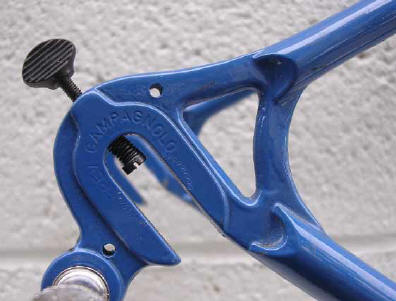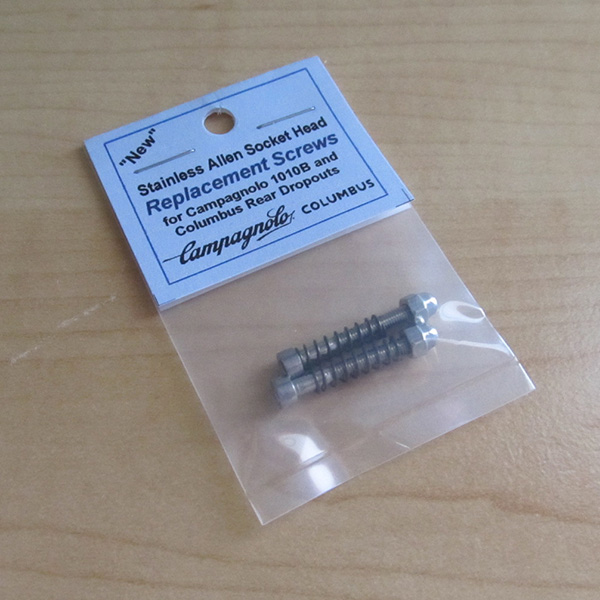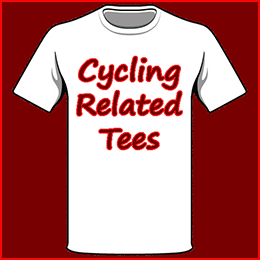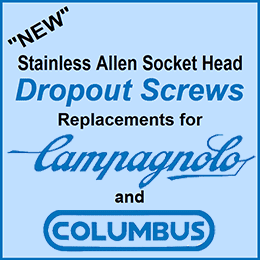Rear Dropouts
 Mon, February 15, 2016
Mon, February 15, 2016
 Have you ever had the misfortune to break an adjuster screw in a rear dropout?
Have you ever had the misfortune to break an adjuster screw in a rear dropout?
Or worse still a thread tap which is hardened and can’t be drilled out.
The best way to deal with this problem is to seek out an engineering company who have Electrical Discharge Machining (EDM) equipment. This machine can burn through steel with precision using very little heat.
I would occasionally break a tap in the dropout of a brand new painted and finished frame. I would take it to a local EDM shop where they would burn out the broken tap and not even touch or mar the paint work, and not charge me too much money.
On another subject have you ever wondered what those two little threaded holes are for in the right hand side Campagnolo short rear dropout. Mostly seen on frames built through the 1980s. (See the picture above.)
This was for a special chain hanger Campagnolo introduced in 1977. Called a Portacatena, it consisted of a “C” shaped steel plate that attached to the inside of the rear dropout with two screws in the threaded holes I just pointed out.
The idea was in the event of a flat tire, with the aid of a special extra lever on your down tube shift lever, the chain could be shifted onto the Portacatena chain holder where it would stay while the wheel was being changed.
After the wheel change, the rider got a push start and then shifted the chain onto the rear freewheel in the usual way. The idea never really caught on because it was only suited to a race team with support kind of situation. It was also necessary to use a five-speed freewheel on a six-speed hub spacing (125mm.)
Soon after its introduction six speed freewheels became commonplace and the idea died a natural death. In spite of this Campagnola continued to produce rear dropouts with these two threaded holes to my knowledge through the early 1990s. Why? I have no idea.
 Finally, while on the subject of rear dropouts, I have been selling stainless steel replacement dropout adjuster screws for about three years now.
Finally, while on the subject of rear dropouts, I have been selling stainless steel replacement dropout adjuster screws for about three years now.
Recently When I replenished my stock I decided to change over to Allen socket head screws.
These are fiddley little beggars to fit with a flat screwdriver, Allen head screws make the job a whole lot easier.
A long "T" handle Allen wrench would work nicely with these screws, as long as the handle clears the chainstays. The ideal tool is a nut driver, which takes a hex socket for tightening small hexagonal head screws and nuts. (Picture below.)

The required size 2.5mm. Allen tool bit then fits into the appropriate size socket and fitting these new screws is a walk ride in the park.
If the threads in your frame happen to be full of rust, or dirt and the screw comes to a grinding halt, don’t force it but rather apply some grease to the screw, and each time you come to a stop, back off (Unscrew) half a turn or so, then go forward again.
 Each time you will usually progress a little further before having to back off again.
Each time you will usually progress a little further before having to back off again.
Patience is the key, rather than trying to force the screw in and end up breaking it. (Which is where we started today.)
(Picture right.) I sell these new stainless screws on eBay for $9.50 a pair, and postage is free anywhere in the world. They weigh less than an ounce and go in a regular business envelope with a stamp. There is also a permanent ad in the right column of this page.
 Dave Moulton | Comments Off |
Dave Moulton | Comments Off | 


















Reader Comments (11)
And wonderful little adjusters they are.
I got a set from a friend before I even knew of this blog.
I will be buying some of the new style also.
Well done Dave.
I had a broken bolt EDM'ed out of a cylinder head a number of years ago and it was like magic. Cut the center of the bolt out and then pulled the threads out of the parent metal magnetically. Like you said, never touched the cyl. block.
I've seen Portacatena's used on randonneur bicycles, and gotta say that it'd be nice to repair a flat without handling the chain.
Oh, and a belated Happy Birthday Dave.
I guess I could look it up, but do you know would these screws fit the dropouts in a Surly CrossCheck? Or is this only for a specific vintage dropout standard?
My screws are 3mm x 25mm long (+ the head is another 3mm.) The Surley Cross Check screws look the same but maybe a little longer. You can always send them back if they don't work.
Dave
The best use of adjuster screws is to remove them as soon as you get the frame. I've had too many break off or rust in the dropout over the last 40 years of bike ownership to appreciate they might have a use. Fortunately, vertical dropouts have come to the rescue :-)
Yoav-
With all due respect, how's your bike maintenance in general? The reason I ask is that in 30 plus years of riding I've never had an adjuster screw freeze up or break off in the dropout. Maybe I'm lucky...?
Hi Dave,
My two cents. Use "anti-seize" compound on all the threads, seat posts etc..... Been wrenching since 1976 and I live at the beach. Salt, sand, sweat etc... all help to corrode threads. By using anti-seize it will always come apart again. Just sayin'
The quality of the original screws was so poor that it only took one ride in winter rain and road salt to seize them in the dropouts. Fortunately, I only have one bike left with these old fashioned dropouts so maybe I'll splash out on a pair of Mr Moulton's screws.
It really is a very necessary thing! Especially when you travel a lot on the rear wheel
you travel a lot on the rear wheel
Hey Dave,
This one just sold on Goodwill. I would have purchased, but i ride a 59cc.
cheers right.
http://www.shopgoodwill.com/viewItem.asp?ItemID=28298680